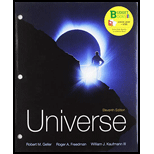
Concept explainers
(a)
The distance between two clusters at the point in time when light was emitted from HS 1946+7658 to produce an image on Earth tonight. Suppose that the distance between two clusters of galaxies is
(a)
Answer to Problem 42Q
Solution:
Explanation of Solution
Given data:
The redshift for the quasar HS 1946+7658 is 3.02.
The distance between two clusters in present day universe is
The density of matter in today’s universe is
Formula used:
The distance between the two clusters when light was emitted from a quasar is:
Here, z is the redshift.
Explanation:
Recall the expression for the distance between the two clusters:
Substitute 3.02 for z and
Conclusion:
Therefore, the distance between the two clusters is
(b)
The average density of the matter
(b)
Answer to Problem 42Q
Solution:
Explanation of Solution
Given data:
The density of today’s universe is
The redshift for the quasar HS 1946+7658 is 3.02.
Formula used:
The relationship between redshift and average density is:
Here,
Explanation:
Recall the relationship between redshift and average density.
Substitute 3.02 for z and
Conclusion:
Therefore, the average density is
(c)
The temperature of the cosmic background
(c)
Answer to Problem 42Q
Solution:
Explanation of Solution
Given data:
The redshift for the quasar HS 1946+7658 is 3.02.
Formula used:
The relationship between the mass density of radiation and the background temperature is:
Here,
Explanation:
The temperature of the background radiation would have been 4.02 times greater because the expansion of the universe increased by a factor 4.02
So, the background temperature is:
Recall the relationship between mass density of radiation and background temperature.
Substitute
Conclusion:
Therefore, the mass density of radiation is
(d)
Whether the universe was matter-dominated, radiation dominated, or dark energy-dominated in the distant past, at the point in time when light was emitted from HS 1946+7658 to produce an image on earth tonight. Suppose that the distance between two clusters of galaxies is
(d)
Answer to Problem 42Q
Solution:
Matter dominated
Explanation of Solution
Given data:
The redshift for the quasar HS 1946+7658 is 3.02.
The distance between two clusters in the present-day universe is
The density of today’s universe is
Formula used:
The relationship between redshift and average density is:
Here,
The relationship between mass density of radiation and background temperature is:
Here,
Explanation:
The average density
The mass density of radiation
From these results, it is concluded that
Conclusion:
Therefore, the universe was matter dominated.
Want to see more full solutions like this?
Chapter 25 Solutions
Universe - Text Only (Looseleaf)
- Show that no matter how big a redshift (z) we measure, v/c will never be greater than 1. (In other words, no galaxy we observe can be moving away faster than the speed of light.)arrow_forwardSuppose that the universe were full of spherical objects, each of mass m and radius r, with the objects distributed uniformly throughout the universe as in the previous problem. (Assume nonrelativistic objects.) Given the density of these spherical objects (as you would have found in the previous problem), how far would you be able to see in meters, on average, before your line of sight intersected one of them? Values (note, different from the above problem): m = 3 kg r = 0.03 m Answer must be in scientific notation and include zero decimal places (1 sig fig).arrow_forwardA galaxy is observed to recede at speed 140 km/s. If the Hubble constant is 70 km/s/ Mpc, how far is the galaxy?arrow_forward
- Some of the familiar hydrogen lines appear in the spectrum of quasar 3C9, but they are shifted so far toward the red that their wavelengths are observed to be 3.0 times as long as those observed for hydrogen atoms at rest in the laboratory. (a) Show that the classical Doppler equation gives a relative velocity of recession greater than c for this situation. (b) Assuming that the relative motion of 3C9 and Earth is due entirely to the cosmological expansion of the universe, find the recession speed that is predicted by the relativistic Doppler equation.arrow_forwardThe red-shift of a galaxy observed by us corresponds to a speed of 50000 km/s. How far is the galaxy from us approximately? A. 700 Mpc B. 70 Mpc C. 7 Mpc D. 7 Gpc Is the answer A? Thank you!arrow_forwardWhat is the Lorentz factor and speed of a quasar with a red light wavelength of 510 nm and rest frame of 148 nm?arrow_forward
- What speed should a galaxy move with respect to us so that the sodium line at 589.0 nm is observed at 589.6 nm?arrow_forwardWhat mechanism can simultaneously solve both the flatness and horizon problems in cosmology?arrow_forwardDistances to local galaxies are determined by measuring the brightness of stars, called Cepheid variables, that can beobserved individually and that have absolute brightnesses at a standard distance that are well known. Explain how the measuredbrightness would vary with distance as compared with the absolute brightness.arrow_forward
 Principles of Physics: A Calculus-Based TextPhysicsISBN:9781133104261Author:Raymond A. Serway, John W. JewettPublisher:Cengage Learning
Principles of Physics: A Calculus-Based TextPhysicsISBN:9781133104261Author:Raymond A. Serway, John W. JewettPublisher:Cengage Learning Physics for Scientists and Engineers with Modern ...PhysicsISBN:9781337553292Author:Raymond A. Serway, John W. JewettPublisher:Cengage Learning
Physics for Scientists and Engineers with Modern ...PhysicsISBN:9781337553292Author:Raymond A. Serway, John W. JewettPublisher:Cengage Learning Modern PhysicsPhysicsISBN:9781111794378Author:Raymond A. Serway, Clement J. Moses, Curt A. MoyerPublisher:Cengage Learning
Modern PhysicsPhysicsISBN:9781111794378Author:Raymond A. Serway, Clement J. Moses, Curt A. MoyerPublisher:Cengage Learning Foundations of Astronomy (MindTap Course List)PhysicsISBN:9781337399920Author:Michael A. Seeds, Dana BackmanPublisher:Cengage Learning
Foundations of Astronomy (MindTap Course List)PhysicsISBN:9781337399920Author:Michael A. Seeds, Dana BackmanPublisher:Cengage Learning Stars and Galaxies (MindTap Course List)PhysicsISBN:9781337399944Author:Michael A. SeedsPublisher:Cengage Learning
Stars and Galaxies (MindTap Course List)PhysicsISBN:9781337399944Author:Michael A. SeedsPublisher:Cengage Learning AstronomyPhysicsISBN:9781938168284Author:Andrew Fraknoi; David Morrison; Sidney C. WolffPublisher:OpenStax
AstronomyPhysicsISBN:9781938168284Author:Andrew Fraknoi; David Morrison; Sidney C. WolffPublisher:OpenStax





